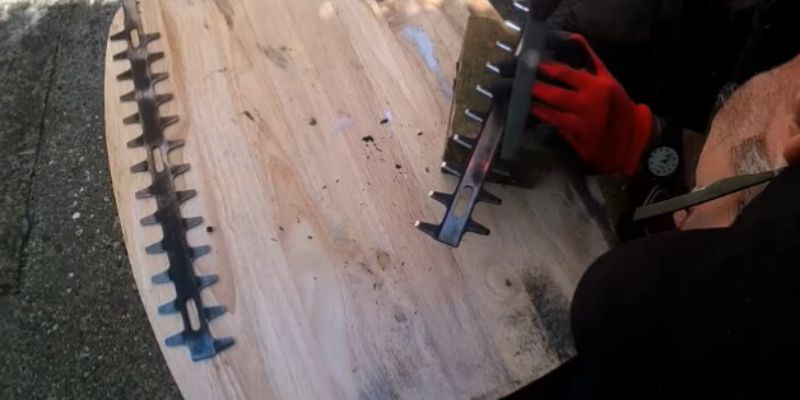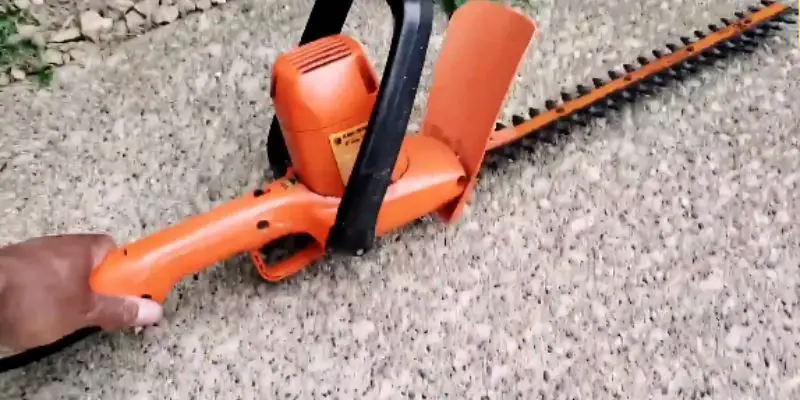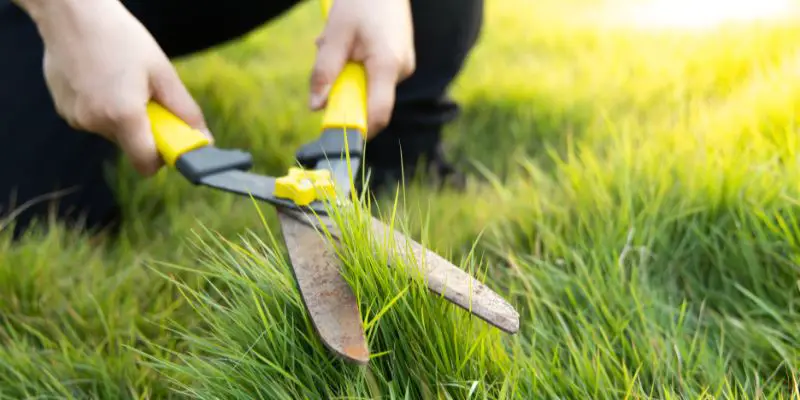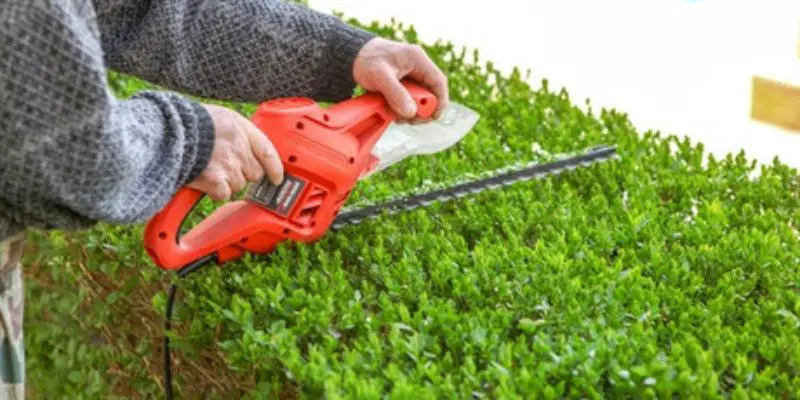As an avid gardener with over 15 years of experience using all kinds of yard tools and equipment, I’ve sharpened my fair share of hedge trimmer blades. While keeping the blades on your Black and Decker electric hedge trimmer nice and sharp is important for ensuring clean, healthy cuts, it can seem intimidating if you’ve never done it before. Not to worry! With the right techniques and tools, you can easily learn how to sharpen Black and Decker electric hedge trimmer blades right at home.
In this comprehensive guide, I’ll share my proven process for sharpening Black and Decker hedge trimmer blades quickly and efficiently. You’ll learn hedge trimmer blade anatomy, signs it’s time to sharpen, what tools you need, and step-by-step instructions from start to finish. Let’s get started!
Why Proper Sharpening Matters
Before we dive into the how-to, let’s first look at why keeping your Black and Decker hedge trimmer blades sharp is so important:
1. Prevent Tearing and Ragged Cuts
Sharp blades make clean, precise cuts while dull blades tear and shred the stems instead of cutting them. Clean cuts help plants heal quicker.
2. Reduce Risk of Disease Transmission
Ragged cuts leave the plant stems vulnerable to infection. Sharp blades reduce this risk.
3. Lessen Fatigue
Cutting with dull blades requires more force and wear you out faster. Sharpened blades cut easier and reduce fatigue.
4. Extend Machine Life
Forcing a dull blade through branches puts strain on the hedge trimmer motor. Sharpening reduces friction and saves unnecessary wear.
5. Improve Cutting Efficiency
Sharp blades cut faster than dull ones. You’ll zip through hedges with ease after sharpening.
So in short, properly maintaining your Black and Decker hedge trimmer blades by sharpening them regularly helps your plants, the machine, and you! Now let’s look at the signs that tell you it’s time to sharpen.
When to Sharpen Your Hedge Trimmer Blades
You don’t need to sharpen hedge trimmer blades after every use. But it’s important to monitor them and sharpen when you notice these signs:
- Ragged, torn cuts instead of clean slices
- Stems get crushed or squeezed instead of cut
- Hedge trimmer motor bogging down while cutting
- Increased vibration while trimming
- Blades struggling to cut stems they used to slice through
- Having to press hard to get stems to cut
If you notice any of these warning signs, your Black and Decker hedge trimmer blades likely need sharpening. Catching dull blades early and sharpening them prevents unnecessary strain on the motor and damaged plants.
Now let’s go over the simple tools you need for DIY sharpening.
Supplies Needed to Sharpen Hedge Trimmer Blades
Sharpening your Black and Decker electric hedge trimmer blades is a quick and easy process—you just need a few basic supplies:
- Flat file – A coarse metal file with a flat surface works best to sharpen the beveled blade edge. Look for an 8-10 inch mill file.
- Gloves – Protect your hands from the blades while sharpening. Thick work gloves are ideal.
- Safety glasses -Sharpening throws debris, so glasses keep your eyes safe.
- Vise – A bench vise holds the hedge trimmer firmly while you work.
- Rag & cleaner – For wiping down blades when finished to remove metal filings and dirt.
- Lubricating oil – Prevents rust and keeps blades moving smoothly.
And that’s it! Having these simple items on hand makes the sharpening process much easier. Now let’s get into the step-by-step process.
How to Sharpen Black and Decker Electric Hedge Trimmer Blades
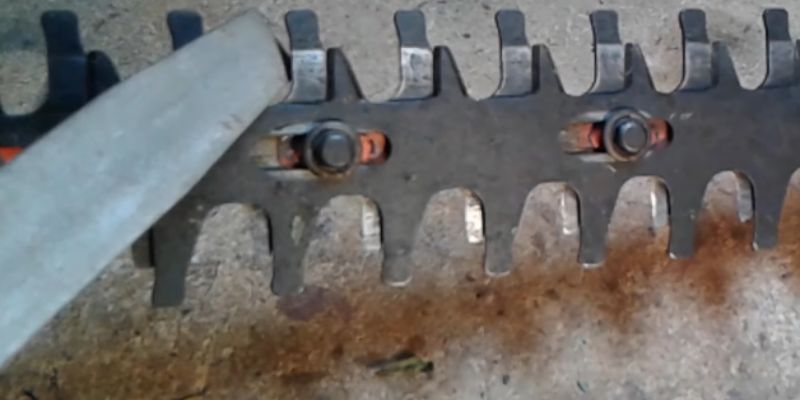
Ready to learn how to get your Black and Decker electric hedge trimmer blades razor sharp? Follow these steps:
Step 1: Disconnect Power Supply
Before doing any work on your hedge trimmer, always disconnect it from the power source to avoid accidental starting. For corded electric models, unplug it. For cordless, remove the battery.
Step 2: Clean the Blades
Use a small wire brush to scrub away any dirt, debris, sap, or rust buildup on the hedge trimmer blades. Removing any gunk now prevents contamination while sharpening.
Step 3: Secure in a Vise
Lock your hedge trimmer horizontally in a vise, with the bottom blade facing upward. Crank the vise tightly to hold the trimmer still while sharpening.
Step 4: Protect Your Hands
Before sharpening hedge trimmer blades, always wear thick work gloves to protect your hands from the sharp edges. Leather welding gloves work great.
Step 5: Sharpen the Beveled Edge
With gloved hands, take your coarse flat mill file and sharpen the beveled edge of the bottom blade with firm, even strokes towards the blade tip. Use moderate pressure as you drag the file away from yourself. Lifting on each return stroke prevents rounding the edge. Rest the file face flat on the blade and hold it at a 25-30° angle. Work slowly and methodically. Let the file do the work—no need to bear down hard.
Step 6: Switch Sides
Once sufficiently sharpened on one side, rotate the hedge trimmer 180° to access the other side of the bottom blade. Repeat the same sharpening process, filing at a 25-30° angle towards the tip.
Step 7: Flip Over
Next, rotate the entire hedge trimmer assembly 180° to access the top blade. Crank the vise tighter. Repeat Steps 5-6 to sharpen both sides of the top blade at a 25-30° angle.
Step 8: Remove Metal Burrs
Examine the cutting edges for any rolled metal burrs. Use a smooth flat stone to lightly hone away any imperfections.
Step 9: Clean the Blades
Remove all metal filings from sharpening with a stiff wire brush. Wipe the blades down with a cleaner-soaked rag. Lubricate with oil to prevent rust.
Step 10: Test Cut
Reconnect your hedge trimmer power supply and make some test cuts on scrap branches to ensure proper sharpness before trimming hedges again.
And that’s all there is to it! With these simple steps for how to sharpen Black and Decker electric hedge trimmer blades, you can maintain razor-sharp cutting edges for clean, healthy hedge trims.
FAQs About Sharpening Hedge Trimmer Blades
Let’s go over some common questions people have about how to sharpen Black and Decker electric hedge trimmer:
How often should you sharpen hedge trimmer blades?
It depends on how much you use them, but a good rule of thumb is to sharpen at least once per year before peak trimming season. More frequent sharpening is needed if you use it commercially.
What sharpening angle is best?
Aim for a 25-30 degree sharpening angle. This gives the best cutting edge for hedge trimmer blades.
Can I sharpen just one blade side?
Always sharpen both the top and bottom blades, and both beveled edges of each blade. This maintains balance and performance.
What if one blade is damaged?
It’s possible to replace only one blade, but best practice is to replace both together as a set for optimum cutting.
How can I prevent rust on blades after sharpening?
Always clean blades after sharpening and apply a light lubricating oil. Wipe off debris before storing. Check periodically for signs of rust.
Can I sharpen titanium hedge trimmer blades?
Titanium-coated blades will wear down over time. When nicked or dull, they can be sharpened just like other steel blades.
What if my blades are heavily damaged?
If your blades are excessively worn, chipped, or bent, replacement may be better than salvaging them by sharpening.
And those are the most common questions about keeping your Black and Decker hedge trimmer blades in top form through proper sharpening.
Conclusion
Regularly sharpening the blades on your Black and Decker electric hedge trimmer is essential for maintaining the cleanest, healthiest cuts and peak trimmer performance. Letting the blades get dull forces the motor to work harder while damaging plants.
But as you now know, sharpening hedge trimmer blades is a quick and simple process when armed with the right tools and techniques. Following the step-by-step guide outlined, you can easily sharpen your trimmer blades to factory sharpness. Just be sure to monitor for signs of dulling and sharpen proactively.
With a quality coarse file, sturdy vise, and proper angling method, you can sharpen those Black and Decker hedge trimmer blades yourself and have confidence tackling landscape hedges knowing the edges are razor-sharp. So don’t let dull blades bog down your trimmer and harm your hedges—sharpen regularly and enjoy the benefits of optimized cutting performance.
Your plants and equipment will thank you! And you’ll gain satisfaction knowing you sharpened the blades properly yourself.
Also read:
Best Electric Hedge Trimmer – Top 5 Picks and Buying Guide

Michael Glenn is a certified arborist and horticultural expert with over 15 years of experience in the landscape industry. His passion for plants and trees has led him to become a sought-after authority on pruning and trimming techniques. Glenn’s in-depth knowledge of proper pruning methods, timing, and tools has helped countless homeowners and professionals maintain healthy, aesthetically pleasing gardens and landscapes.
In addition to sharing his pruning expertise through practical tips, step-by-step guides, and expert advice, Glenn is also a respected author of pruning tool buying guides. His comprehensive reviews and comparisons ensure readers can make informed decisions when investing in quality loppers, pruning shears, saws, and other essential equipment. With a deep understanding of plant biology and sustainable practices, Glenn’s writing empowers audiences with the knowledge needed to properly care for green spaces.

